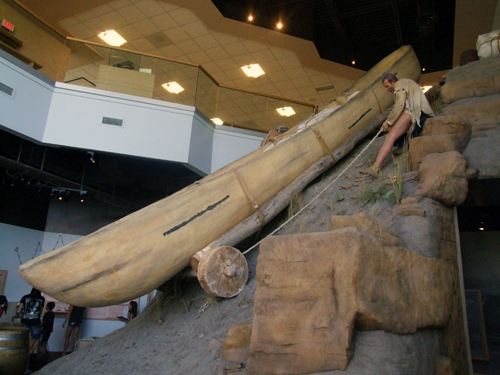
-Fourteenth in a series-
By Donald H. Harrison
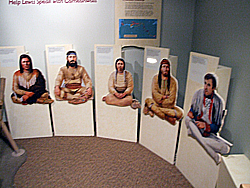
GREAT FALLS, Montana – There are numerous eye-catching exhibits at the Lewis & Clark National Historic Interpretive Center here, including a life-size display showing how the early 19th century American explorers Meriwether Lewis and William Clark had to drag their boats around the five cascades of Great Falls, a project that unexpectedly delayed their 1805 overland journey of exploration to the West Coast.
I must confess that I was far more intrigued by the process and personnel that Lewis had to utilize later in the journey in order to negotiate with the Shoshone Indians for horses that could take them on a trail from the Rockies to the Oregon coast.
Lewis spoke only English. The headman of the Shoshone, Cameahwait, spoke only his tribal language, Agui-Dika. So, negotiating around a campfire, Lewis had to go through a chain of interpreters to make his wishes known to Cameahwait. And when the Shoshone answered Lewis, the conversation flowed through three intermediaries in the opposite direction.
In English, Lewis said something to the effect of “I would like to buy some horses for our party.” A member of his “Corps of Exploration,” Francois Labiche, spoke both English and French. He relayed the message in French to Toussaint Charbonneau, who spoke French and the Nuxbaaga language of the Hidatsa Indians.
Charbonneau next relayed the message to Sacagawea, his later-to-become-celebrated wife, who spoke both the language of the Hidatsa, who had captured her five years earlier, and her native Agui-Dika language of the Shoshone. Sacagawea relayed the message in Agui-Dika to Cameahwait, and upon his reply, told her husband, Charbonneau, in Nuxbaaga, what the man had said.
An interactive display at the Lewis and Clark Center National Historic Interpretive Center allows visitors, by pushing buttons, to puzzle out the sequence of the conversation. The exercise got me thinking about the Jewish peddlers who years later would follow Lewis and Clark through the American West, offering the goods on their back or in their wagons for sale or trade to the people they met along the way, whatever their languages might be.
No doubt Lewis and Clark also resorted to hand gestures and other methods of sign language in their dealings with the various Native American groups they met along their way. So, too, would the Jewish merchants have employed this mode of communication. Jewish peddlers had the advantage over Lewis and Clark in that many of them spoke not one but several languages, thereby greatly multiplying the number of people who might serve as links in the communications chain.
I am most familiar with the story of Louis Rose, who became in 1850 the first Jewish settler in San Diego, California, my home town. Rose grew up in Neuhaus-an-der-Oste, Germany, and was able to speak and write not only German, but also English, French, and Spanish.
Meriwether Lewis, in the above described sequence, had only Labiche to speak to directly, whereas Rose could have spoken directly to either Labiche or Charbonneau, or possibly to other members of the parlay who might have known Spanish or German. Rose’s opportunity to successfully conduct a transaction would have been greatly enhanced by his multilingualism.
My grandson Shor, with whom I travelled on this journey up the Interstate 15 from San Diego to Grand Rapids, and to Canada beyond, will be taking Spanish courses in the Fall as an 8th grader. In my opinion, he makes a wise choice in his language selection, not only because San Diego is near the Mexican border and many people in Southern California speak Spanish—although that is reason enough. Knowing another language can bring unexpected opportunities in your life that would never otherwise present themselves.
There used to be a joke around the city room of the Los Angeles Times that Ruben Salazar was destined to become a successful war correspondent in Vietnam because he spoke Spanish. That’s not as far-fetched as it sounds. When President Lyndon B. Johnson sent troops to the Spanish-speaking Dominican Republic in 1965, editors came out to the Times’ city room and asked, “who speaks Spanish?” Salazar, of Mexican descent, raised his hand. “Do you want to cover this action in the Dominican Republic?” Yes, said Salazar, he did. And he was so good at it, that he made his reputation as a war correspondent. So when the Vietnam War started to heat up, it was natural that Salazar would go to Vietnam for the Times.
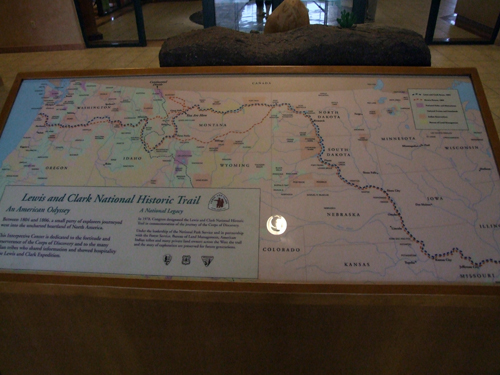
The story told at the Lewis & Clark National Historic Trail Interpretive Center is one of bravery and ingenuity. To imagine the sense of wonder and excitement that these historically forever-paired explorers and their party felt as they became the first Americans of European heritage to see the North American interior, one might have to fast forward on the calendar to 1969 when Neil Armstrong and the Apollo 11 crew became the first earthlings to set foot on the moon.
Some of the high points of the historic journey are recalled in film, Confluence of Time and Courage: Lewis and Clark, which is shown regularly in the interpretive center’s auditorium. At Fort Mandan, not far from present-day Bismarck, North Dakota, Lewis & Clark met Charbonneau along with his captive wife Sacagawea. “Hidatsa,” the tribal group that captured Sacagawea, sounds a little bit like “Hadassah,” the Jewish women’s group that supports Israel’s famous medical centers. Homonyms—words that sound alike—are forever a danger when people must rely, as Lewis and Clark did, on interpreters.
Sacagawea gave birth to Charbonneau’s son, Jean-Baptiste, on February 11, 1805, and two months later, her husband, her baby and she left on April 17, on the historic journey in a party of 33 people and one Newfoundland dog named “Seaman.”
Native Americans had warned Lewis that along the way he might run into giant and ferocious bears, but he discounted their warnings as “tall tales,” at least until his party met grizzly bears up close and personal. “Men were chased and treed,” the video relates. “Even after multiple shots, the bears kept coming.” On one occasion, Lewis didn’t have time to reload when a grizzly charged him. He ran to the river with the grizzly giving full chase. “Waist deep in water, Captain Lewis faced his attacker,” narrated the video. “Unloaded, his rifle was useless as he defended himself only with the sharp point of his espontoon.” Luckily, the bayonet-like appendage was enough to scare off the bear.
Lewis and Clark knew that there were water falls at Great Falls, but were unaware that there were so many of them. They had expected to see one big cascade. Instead they found five over a course of several miles around which they would have to detour on land, pulling their boats along with them.
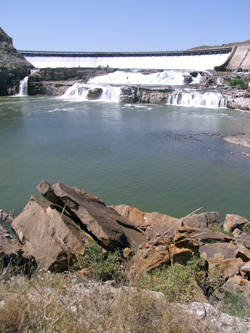
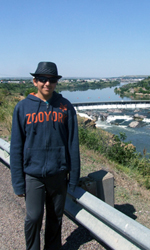
They had to cut down cottonwood trees to build rounds to serve as wheels of an improvised vehicle to carry their dugout canoes and cargo. In addition to the time expended building these vehicles, the portage required four 18-mile cross country trips, altogether consuming a month from mid-June to mid-July. The men’s fatigue was “incredible,” Lewis wrote in his journal. Some members of the party “faint and (are) unable to stand for even a few minutes with heat and fatigue.”
At another point, Sacagawea became ill, and no standard remedy seemed to work. Thinking of the mineral waters the party had discovered earlier at a place he named Silver Spring, Lewis sent men with canteens to fetch what he hoped would be medicinal waters. Coincidence or lucky medicine, the day after she drank the water, Sacagawea began to recover.
From the interpretive center, a visitor can look out the window and see an unspoiled view of the Missouri River—which, speaking of homonyms, sounds a lot like “Masori,” Shor’s last name of Yemenite Jewish origin.
After leaving the interpretive center, we decided to do a little more exploring, and so drove to Ryan Dam, reached via a dirt road that took us over hill and dale to a swaying suspension footbridge. We walked gingerly across the bridge—mindful of the warning that no more than six people should use it at one time — to Ryan Island from which we obtained a good view of the cascades at Ryan Dam. Not exactly a rugged, Lewis & Clark style exploration, but we found the view and the experience nevertheless invigorating.
_____________________________________________________________________________________________________________________
IF YOU GO: We stayed at the Holiday Inn Express & Suites in Great Falls, which in addition to complimentary wi-fi in the room and a continental breakfast downstairs, boasts a great fall of its own, a 140-foot indoor water slide, which allows you to make a big splash in the pool after rocketing through the slide’s serpentine darkness.
______________________________________________________________________________________________________________________